ICT Report: Business Processes & System Requirements for B Bakery
VerifiedAdded on 2023/06/11
|7
|1853
|61
Report
AI Summary
This report delves into the business processes and system requirements of B Bakery, a company specializing in bakery product production and distribution. It identifies key processes such as supply chain management, production, human resources, and accounting, emphasizing the critical role of an effective accounting information system (AIS) and enterprise resource planning (ERP) implementation. The report highlights the necessity of integrating these systems to enhance decision-making, improve operational efficiency, and ensure competitive pricing. Furthermore, it outlines the essential software features, including data processing, documentation, and managerial reporting, required for successful AIS and ERP implementation within the organization, ultimately aiming to optimize internal controls and provide reliable financial information.
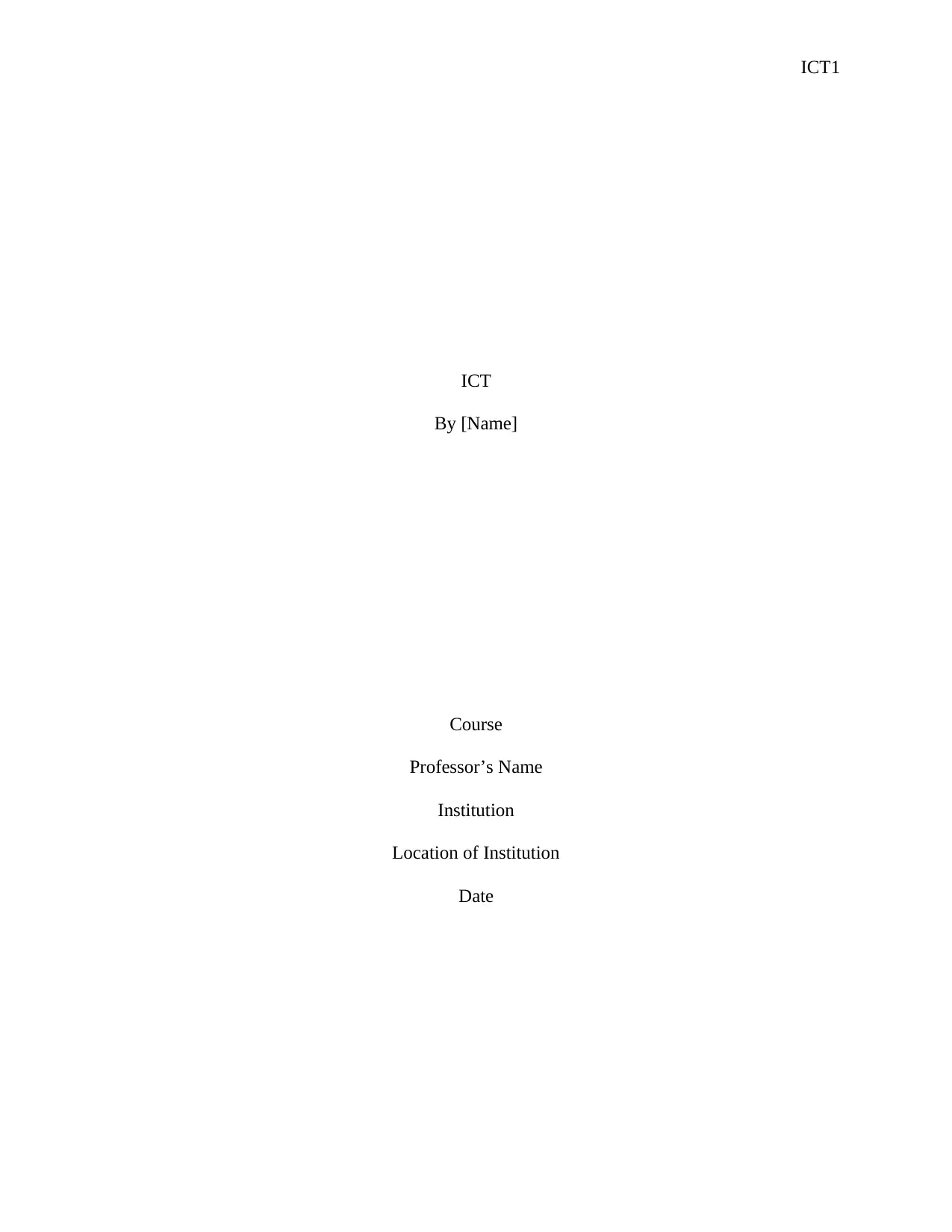
ICT1
ICT
By [Name]
Course
Professor’s Name
Institution
Location of Institution
Date
ICT
By [Name]
Course
Professor’s Name
Institution
Location of Institution
Date
Paraphrase This Document
Need a fresh take? Get an instant paraphrase of this document with our AI Paraphraser
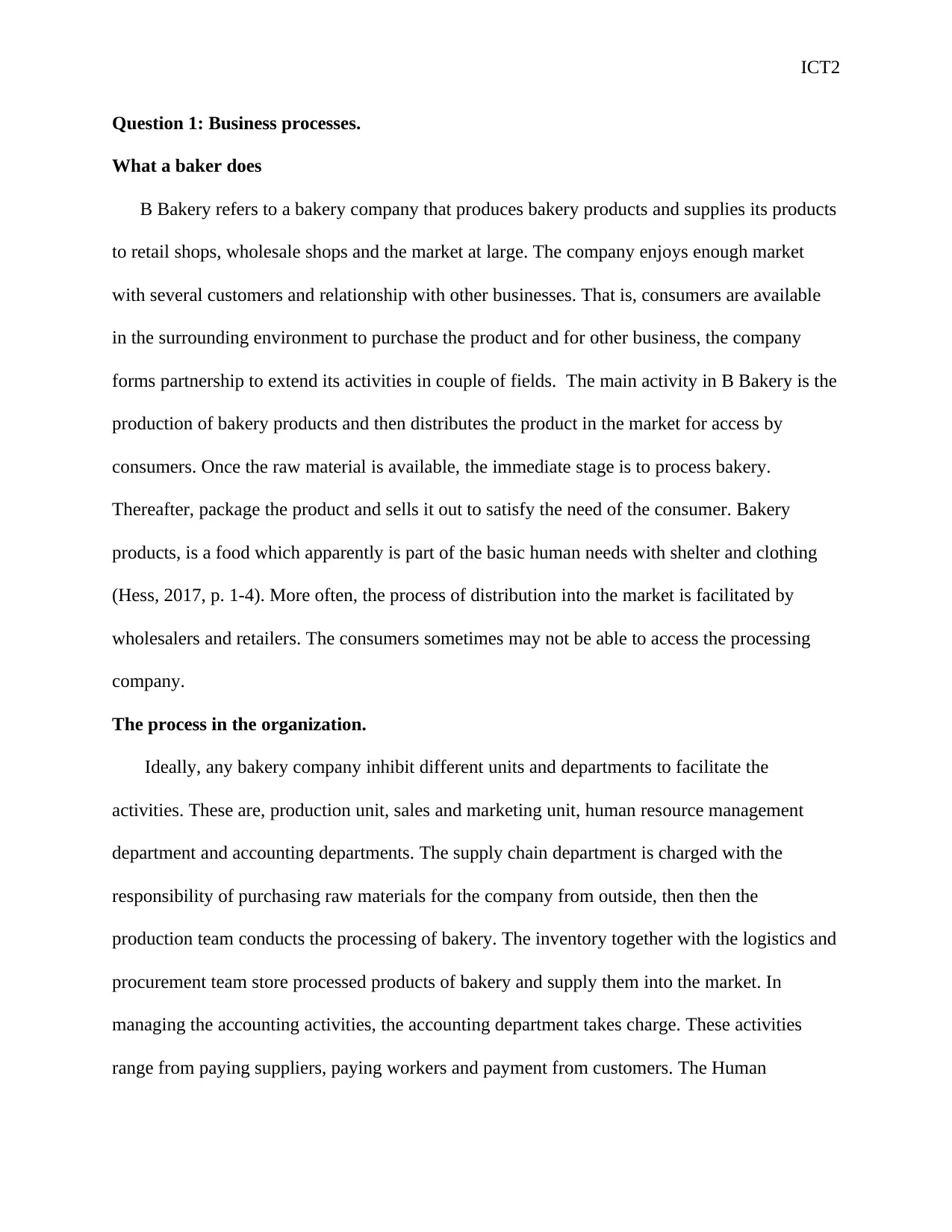
ICT2
Question 1: Business processes.
What a baker does
B Bakery refers to a bakery company that produces bakery products and supplies its products
to retail shops, wholesale shops and the market at large. The company enjoys enough market
with several customers and relationship with other businesses. That is, consumers are available
in the surrounding environment to purchase the product and for other business, the company
forms partnership to extend its activities in couple of fields. The main activity in B Bakery is the
production of bakery products and then distributes the product in the market for access by
consumers. Once the raw material is available, the immediate stage is to process bakery.
Thereafter, package the product and sells it out to satisfy the need of the consumer. Bakery
products, is a food which apparently is part of the basic human needs with shelter and clothing
(Hess, 2017, p. 1-4). More often, the process of distribution into the market is facilitated by
wholesalers and retailers. The consumers sometimes may not be able to access the processing
company.
The process in the organization.
Ideally, any bakery company inhibit different units and departments to facilitate the
activities. These are, production unit, sales and marketing unit, human resource management
department and accounting departments. The supply chain department is charged with the
responsibility of purchasing raw materials for the company from outside, then then the
production team conducts the processing of bakery. The inventory together with the logistics and
procurement team store processed products of bakery and supply them into the market. In
managing the accounting activities, the accounting department takes charge. These activities
range from paying suppliers, paying workers and payment from customers. The Human
Question 1: Business processes.
What a baker does
B Bakery refers to a bakery company that produces bakery products and supplies its products
to retail shops, wholesale shops and the market at large. The company enjoys enough market
with several customers and relationship with other businesses. That is, consumers are available
in the surrounding environment to purchase the product and for other business, the company
forms partnership to extend its activities in couple of fields. The main activity in B Bakery is the
production of bakery products and then distributes the product in the market for access by
consumers. Once the raw material is available, the immediate stage is to process bakery.
Thereafter, package the product and sells it out to satisfy the need of the consumer. Bakery
products, is a food which apparently is part of the basic human needs with shelter and clothing
(Hess, 2017, p. 1-4). More often, the process of distribution into the market is facilitated by
wholesalers and retailers. The consumers sometimes may not be able to access the processing
company.
The process in the organization.
Ideally, any bakery company inhibit different units and departments to facilitate the
activities. These are, production unit, sales and marketing unit, human resource management
department and accounting departments. The supply chain department is charged with the
responsibility of purchasing raw materials for the company from outside, then then the
production team conducts the processing of bakery. The inventory together with the logistics and
procurement team store processed products of bakery and supply them into the market. In
managing the accounting activities, the accounting department takes charge. These activities
range from paying suppliers, paying workers and payment from customers. The Human
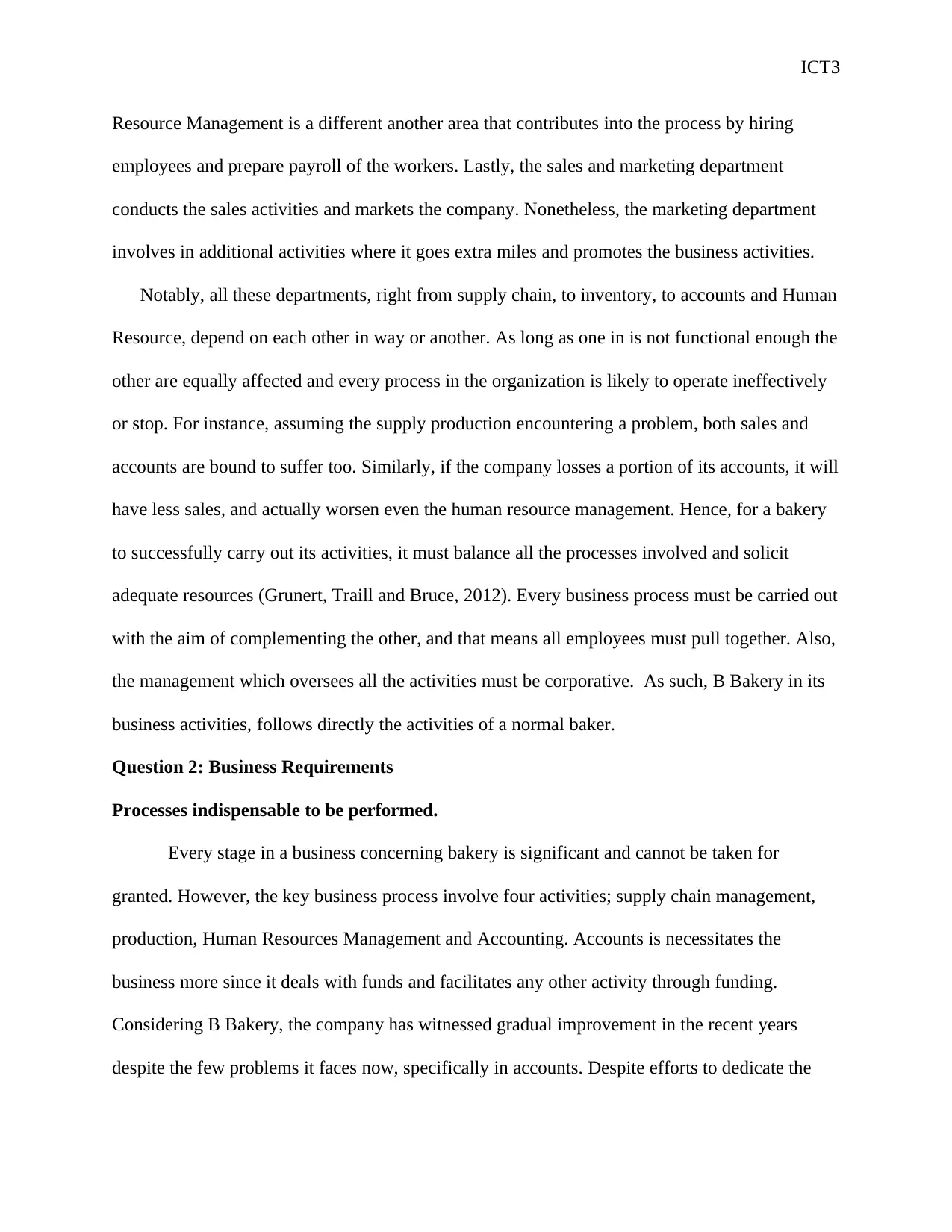
ICT3
Resource Management is a different another area that contributes into the process by hiring
employees and prepare payroll of the workers. Lastly, the sales and marketing department
conducts the sales activities and markets the company. Nonetheless, the marketing department
involves in additional activities where it goes extra miles and promotes the business activities.
Notably, all these departments, right from supply chain, to inventory, to accounts and Human
Resource, depend on each other in way or another. As long as one in is not functional enough the
other are equally affected and every process in the organization is likely to operate ineffectively
or stop. For instance, assuming the supply production encountering a problem, both sales and
accounts are bound to suffer too. Similarly, if the company losses a portion of its accounts, it will
have less sales, and actually worsen even the human resource management. Hence, for a bakery
to successfully carry out its activities, it must balance all the processes involved and solicit
adequate resources (Grunert, Traill and Bruce, 2012). Every business process must be carried out
with the aim of complementing the other, and that means all employees must pull together. Also,
the management which oversees all the activities must be corporative. As such, B Bakery in its
business activities, follows directly the activities of a normal baker.
Question 2: Business Requirements
Processes indispensable to be performed.
Every stage in a business concerning bakery is significant and cannot be taken for
granted. However, the key business process involve four activities; supply chain management,
production, Human Resources Management and Accounting. Accounts is necessitates the
business more since it deals with funds and facilitates any other activity through funding.
Considering B Bakery, the company has witnessed gradual improvement in the recent years
despite the few problems it faces now, specifically in accounts. Despite efforts to dedicate the
Resource Management is a different another area that contributes into the process by hiring
employees and prepare payroll of the workers. Lastly, the sales and marketing department
conducts the sales activities and markets the company. Nonetheless, the marketing department
involves in additional activities where it goes extra miles and promotes the business activities.
Notably, all these departments, right from supply chain, to inventory, to accounts and Human
Resource, depend on each other in way or another. As long as one in is not functional enough the
other are equally affected and every process in the organization is likely to operate ineffectively
or stop. For instance, assuming the supply production encountering a problem, both sales and
accounts are bound to suffer too. Similarly, if the company losses a portion of its accounts, it will
have less sales, and actually worsen even the human resource management. Hence, for a bakery
to successfully carry out its activities, it must balance all the processes involved and solicit
adequate resources (Grunert, Traill and Bruce, 2012). Every business process must be carried out
with the aim of complementing the other, and that means all employees must pull together. Also,
the management which oversees all the activities must be corporative. As such, B Bakery in its
business activities, follows directly the activities of a normal baker.
Question 2: Business Requirements
Processes indispensable to be performed.
Every stage in a business concerning bakery is significant and cannot be taken for
granted. However, the key business process involve four activities; supply chain management,
production, Human Resources Management and Accounting. Accounts is necessitates the
business more since it deals with funds and facilitates any other activity through funding.
Considering B Bakery, the company has witnessed gradual improvement in the recent years
despite the few problems it faces now, specifically in accounts. Despite efforts to dedicate the
⊘ This is a preview!⊘
Do you want full access?
Subscribe today to unlock all pages.

Trusted by 1+ million students worldwide
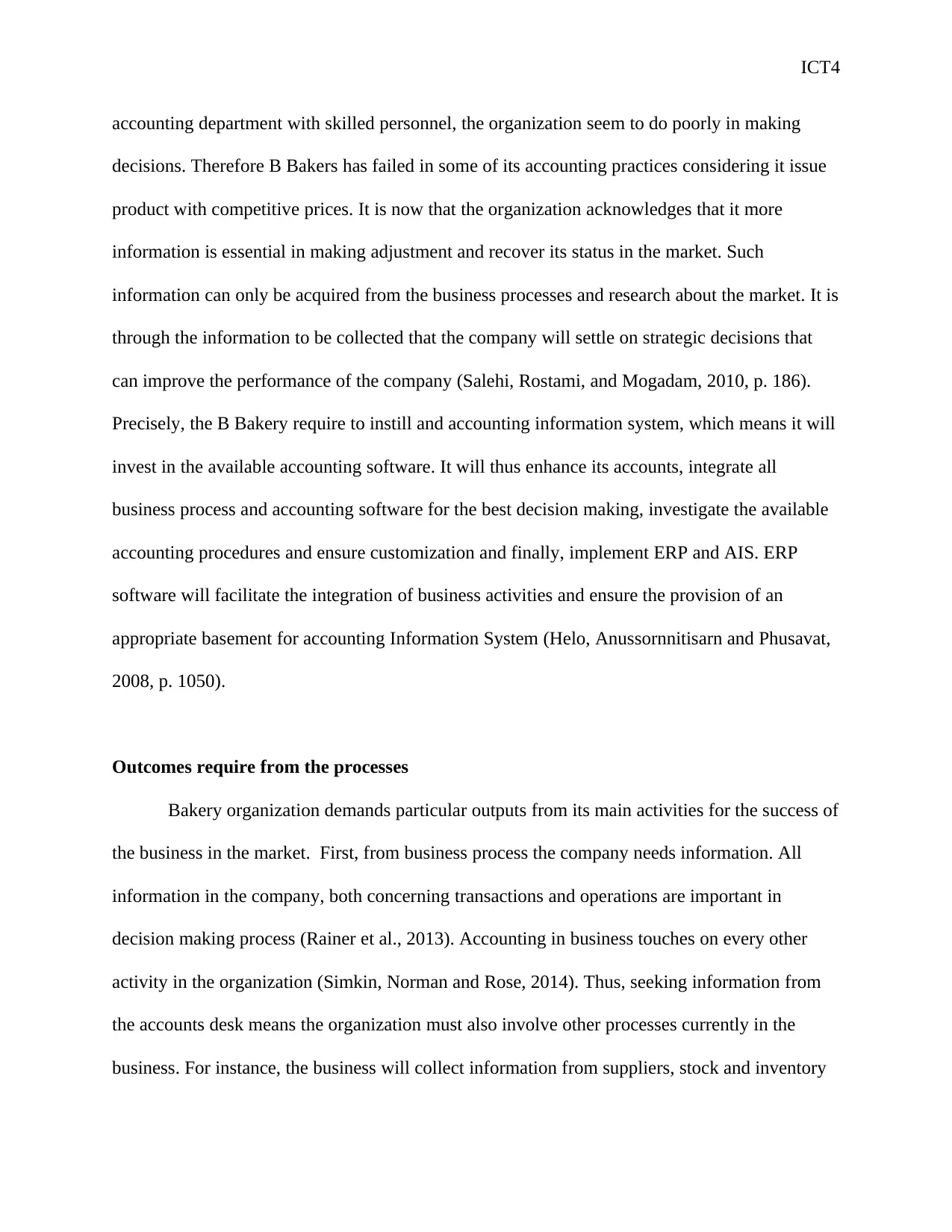
ICT4
accounting department with skilled personnel, the organization seem to do poorly in making
decisions. Therefore B Bakers has failed in some of its accounting practices considering it issue
product with competitive prices. It is now that the organization acknowledges that it more
information is essential in making adjustment and recover its status in the market. Such
information can only be acquired from the business processes and research about the market. It is
through the information to be collected that the company will settle on strategic decisions that
can improve the performance of the company (Salehi, Rostami, and Mogadam, 2010, p. 186).
Precisely, the B Bakery require to instill and accounting information system, which means it will
invest in the available accounting software. It will thus enhance its accounts, integrate all
business process and accounting software for the best decision making, investigate the available
accounting procedures and ensure customization and finally, implement ERP and AIS. ERP
software will facilitate the integration of business activities and ensure the provision of an
appropriate basement for accounting Information System (Helo, Anussornnitisarn and Phusavat,
2008, p. 1050).
Outcomes require from the processes
Bakery organization demands particular outputs from its main activities for the success of
the business in the market. First, from business process the company needs information. All
information in the company, both concerning transactions and operations are important in
decision making process (Rainer et al., 2013). Accounting in business touches on every other
activity in the organization (Simkin, Norman and Rose, 2014). Thus, seeking information from
the accounts desk means the organization must also involve other processes currently in the
business. For instance, the business will collect information from suppliers, stock and inventory
accounting department with skilled personnel, the organization seem to do poorly in making
decisions. Therefore B Bakers has failed in some of its accounting practices considering it issue
product with competitive prices. It is now that the organization acknowledges that it more
information is essential in making adjustment and recover its status in the market. Such
information can only be acquired from the business processes and research about the market. It is
through the information to be collected that the company will settle on strategic decisions that
can improve the performance of the company (Salehi, Rostami, and Mogadam, 2010, p. 186).
Precisely, the B Bakery require to instill and accounting information system, which means it will
invest in the available accounting software. It will thus enhance its accounts, integrate all
business process and accounting software for the best decision making, investigate the available
accounting procedures and ensure customization and finally, implement ERP and AIS. ERP
software will facilitate the integration of business activities and ensure the provision of an
appropriate basement for accounting Information System (Helo, Anussornnitisarn and Phusavat,
2008, p. 1050).
Outcomes require from the processes
Bakery organization demands particular outputs from its main activities for the success of
the business in the market. First, from business process the company needs information. All
information in the company, both concerning transactions and operations are important in
decision making process (Rainer et al., 2013). Accounting in business touches on every other
activity in the organization (Simkin, Norman and Rose, 2014). Thus, seeking information from
the accounts desk means the organization must also involve other processes currently in the
business. For instance, the business will collect information from suppliers, stock and inventory
Paraphrase This Document
Need a fresh take? Get an instant paraphrase of this document with our AI Paraphraser
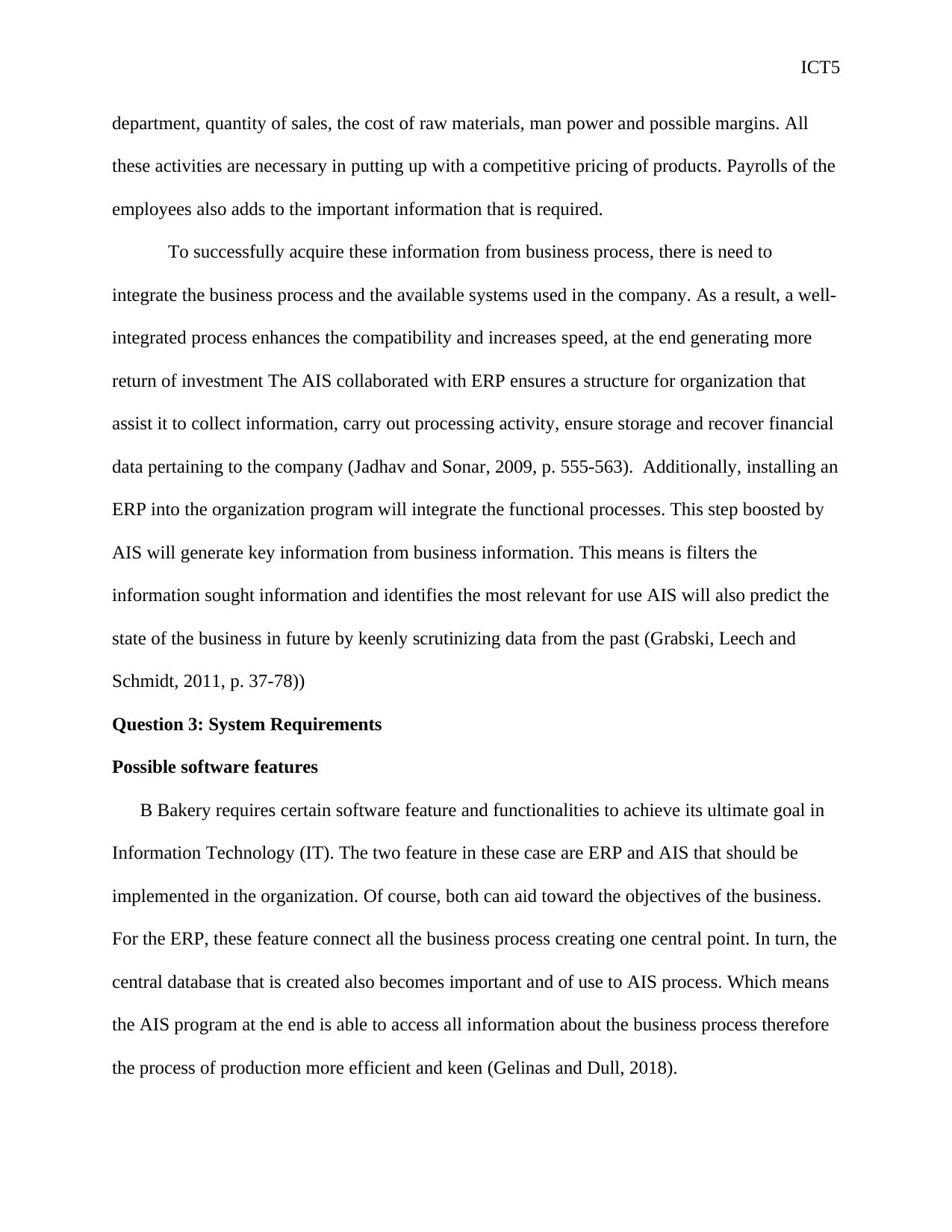
ICT5
department, quantity of sales, the cost of raw materials, man power and possible margins. All
these activities are necessary in putting up with a competitive pricing of products. Payrolls of the
employees also adds to the important information that is required.
To successfully acquire these information from business process, there is need to
integrate the business process and the available systems used in the company. As a result, a well-
integrated process enhances the compatibility and increases speed, at the end generating more
return of investment The AIS collaborated with ERP ensures a structure for organization that
assist it to collect information, carry out processing activity, ensure storage and recover financial
data pertaining to the company (Jadhav and Sonar, 2009, p. 555-563). Additionally, installing an
ERP into the organization program will integrate the functional processes. This step boosted by
AIS will generate key information from business information. This means is filters the
information sought information and identifies the most relevant for use AIS will also predict the
state of the business in future by keenly scrutinizing data from the past (Grabski, Leech and
Schmidt, 2011, p. 37-78))
Question 3: System Requirements
Possible software features
B Bakery requires certain software feature and functionalities to achieve its ultimate goal in
Information Technology (IT). The two feature in these case are ERP and AIS that should be
implemented in the organization. Of course, both can aid toward the objectives of the business.
For the ERP, these feature connect all the business process creating one central point. In turn, the
central database that is created also becomes important and of use to AIS process. Which means
the AIS program at the end is able to access all information about the business process therefore
the process of production more efficient and keen (Gelinas and Dull, 2018).
department, quantity of sales, the cost of raw materials, man power and possible margins. All
these activities are necessary in putting up with a competitive pricing of products. Payrolls of the
employees also adds to the important information that is required.
To successfully acquire these information from business process, there is need to
integrate the business process and the available systems used in the company. As a result, a well-
integrated process enhances the compatibility and increases speed, at the end generating more
return of investment The AIS collaborated with ERP ensures a structure for organization that
assist it to collect information, carry out processing activity, ensure storage and recover financial
data pertaining to the company (Jadhav and Sonar, 2009, p. 555-563). Additionally, installing an
ERP into the organization program will integrate the functional processes. This step boosted by
AIS will generate key information from business information. This means is filters the
information sought information and identifies the most relevant for use AIS will also predict the
state of the business in future by keenly scrutinizing data from the past (Grabski, Leech and
Schmidt, 2011, p. 37-78))
Question 3: System Requirements
Possible software features
B Bakery requires certain software feature and functionalities to achieve its ultimate goal in
Information Technology (IT). The two feature in these case are ERP and AIS that should be
implemented in the organization. Of course, both can aid toward the objectives of the business.
For the ERP, these feature connect all the business process creating one central point. In turn, the
central database that is created also becomes important and of use to AIS process. Which means
the AIS program at the end is able to access all information about the business process therefore
the process of production more efficient and keen (Gelinas and Dull, 2018).
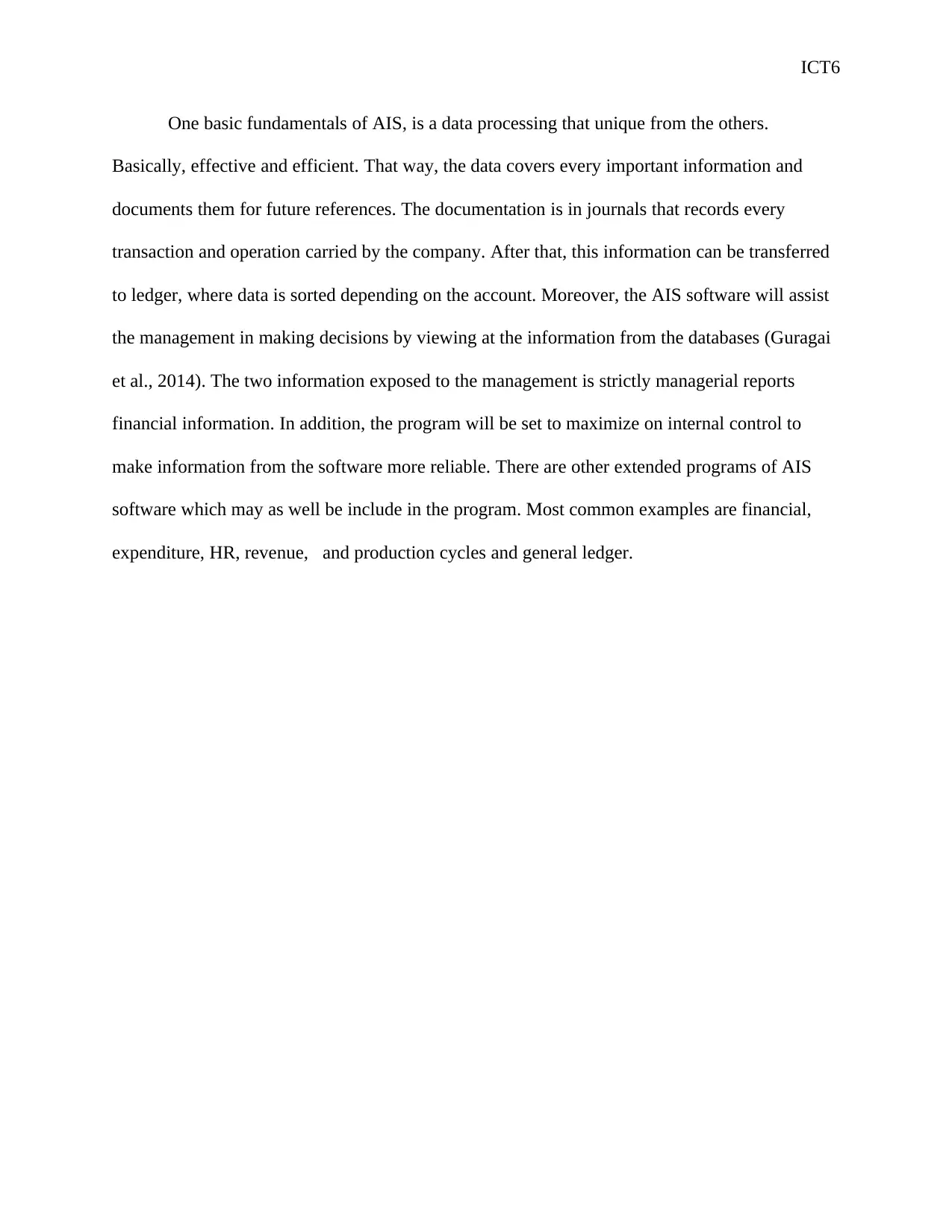
ICT6
One basic fundamentals of AIS, is a data processing that unique from the others.
Basically, effective and efficient. That way, the data covers every important information and
documents them for future references. The documentation is in journals that records every
transaction and operation carried by the company. After that, this information can be transferred
to ledger, where data is sorted depending on the account. Moreover, the AIS software will assist
the management in making decisions by viewing at the information from the databases (Guragai
et al., 2014). The two information exposed to the management is strictly managerial reports
financial information. In addition, the program will be set to maximize on internal control to
make information from the software more reliable. There are other extended programs of AIS
software which may as well be include in the program. Most common examples are financial,
expenditure, HR, revenue, and production cycles and general ledger.
One basic fundamentals of AIS, is a data processing that unique from the others.
Basically, effective and efficient. That way, the data covers every important information and
documents them for future references. The documentation is in journals that records every
transaction and operation carried by the company. After that, this information can be transferred
to ledger, where data is sorted depending on the account. Moreover, the AIS software will assist
the management in making decisions by viewing at the information from the databases (Guragai
et al., 2014). The two information exposed to the management is strictly managerial reports
financial information. In addition, the program will be set to maximize on internal control to
make information from the software more reliable. There are other extended programs of AIS
software which may as well be include in the program. Most common examples are financial,
expenditure, HR, revenue, and production cycles and general ledger.
⊘ This is a preview!⊘
Do you want full access?
Subscribe today to unlock all pages.

Trusted by 1+ million students worldwide
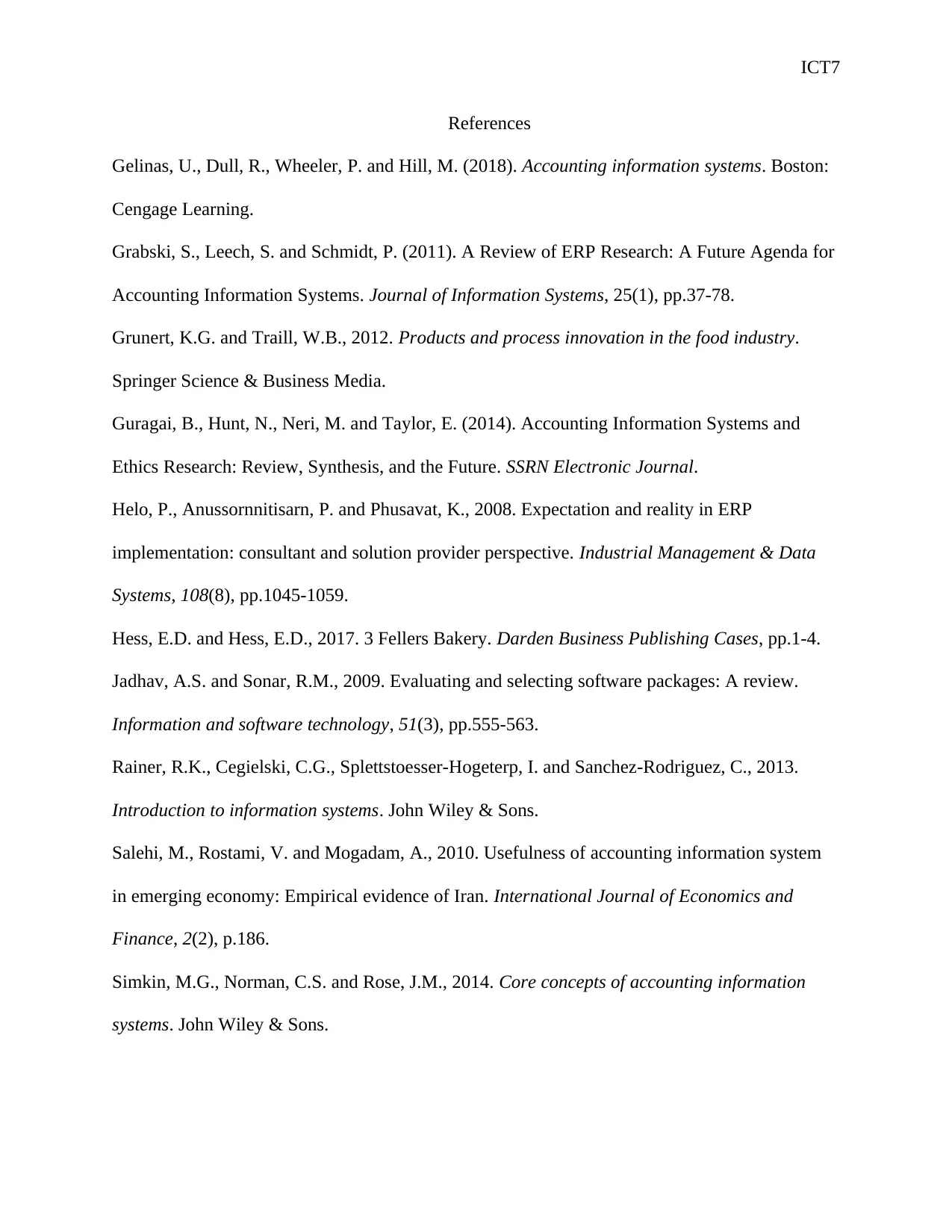
ICT7
References
Gelinas, U., Dull, R., Wheeler, P. and Hill, M. (2018). Accounting information systems. Boston:
Cengage Learning.
Grabski, S., Leech, S. and Schmidt, P. (2011). A Review of ERP Research: A Future Agenda for
Accounting Information Systems. Journal of Information Systems, 25(1), pp.37-78.
Grunert, K.G. and Traill, W.B., 2012. Products and process innovation in the food industry.
Springer Science & Business Media.
Guragai, B., Hunt, N., Neri, M. and Taylor, E. (2014). Accounting Information Systems and
Ethics Research: Review, Synthesis, and the Future. SSRN Electronic Journal.
Helo, P., Anussornnitisarn, P. and Phusavat, K., 2008. Expectation and reality in ERP
implementation: consultant and solution provider perspective. Industrial Management & Data
Systems, 108(8), pp.1045-1059.
Hess, E.D. and Hess, E.D., 2017. 3 Fellers Bakery. Darden Business Publishing Cases, pp.1-4.
Jadhav, A.S. and Sonar, R.M., 2009. Evaluating and selecting software packages: A review.
Information and software technology, 51(3), pp.555-563.
Rainer, R.K., Cegielski, C.G., Splettstoesser-Hogeterp, I. and Sanchez-Rodriguez, C., 2013.
Introduction to information systems. John Wiley & Sons.
Salehi, M., Rostami, V. and Mogadam, A., 2010. Usefulness of accounting information system
in emerging economy: Empirical evidence of Iran. International Journal of Economics and
Finance, 2(2), p.186.
Simkin, M.G., Norman, C.S. and Rose, J.M., 2014. Core concepts of accounting information
systems. John Wiley & Sons.
References
Gelinas, U., Dull, R., Wheeler, P. and Hill, M. (2018). Accounting information systems. Boston:
Cengage Learning.
Grabski, S., Leech, S. and Schmidt, P. (2011). A Review of ERP Research: A Future Agenda for
Accounting Information Systems. Journal of Information Systems, 25(1), pp.37-78.
Grunert, K.G. and Traill, W.B., 2012. Products and process innovation in the food industry.
Springer Science & Business Media.
Guragai, B., Hunt, N., Neri, M. and Taylor, E. (2014). Accounting Information Systems and
Ethics Research: Review, Synthesis, and the Future. SSRN Electronic Journal.
Helo, P., Anussornnitisarn, P. and Phusavat, K., 2008. Expectation and reality in ERP
implementation: consultant and solution provider perspective. Industrial Management & Data
Systems, 108(8), pp.1045-1059.
Hess, E.D. and Hess, E.D., 2017. 3 Fellers Bakery. Darden Business Publishing Cases, pp.1-4.
Jadhav, A.S. and Sonar, R.M., 2009. Evaluating and selecting software packages: A review.
Information and software technology, 51(3), pp.555-563.
Rainer, R.K., Cegielski, C.G., Splettstoesser-Hogeterp, I. and Sanchez-Rodriguez, C., 2013.
Introduction to information systems. John Wiley & Sons.
Salehi, M., Rostami, V. and Mogadam, A., 2010. Usefulness of accounting information system
in emerging economy: Empirical evidence of Iran. International Journal of Economics and
Finance, 2(2), p.186.
Simkin, M.G., Norman, C.S. and Rose, J.M., 2014. Core concepts of accounting information
systems. John Wiley & Sons.
1 out of 7
Related Documents
Your All-in-One AI-Powered Toolkit for Academic Success.
+13062052269
info@desklib.com
Available 24*7 on WhatsApp / Email
![[object Object]](/_next/static/media/star-bottom.7253800d.svg)
Unlock your academic potential
Copyright © 2020–2025 A2Z Services. All Rights Reserved. Developed and managed by ZUCOL.





